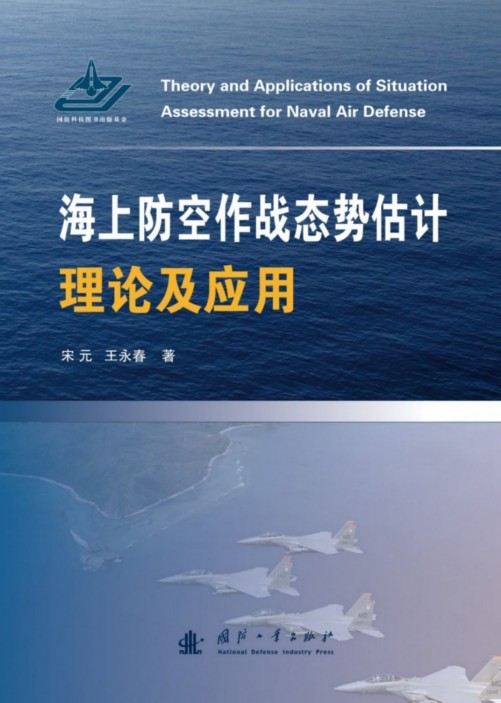基本介紹
- 書名:海上防空作戰態勢估計理論及套用
- 作者:宋元、王永春
- ISBN:978-7-118-09380-3
- 頁數:195頁
- 定價:68.00元
- 出版社:國防工業出版社
- 出版時間:2014年4月
- 裝幀:精裝
- 開本:16開
內容簡介,圖書目錄,
內容簡介
態勢估計是作戰指揮決策的前提和基礎。本書是國內第一部從作戰指揮和高層信息融合的角度,介紹海上防空作戰態勢估計理論、方法及套用的學術專著。全書共分8章,系統介紹了海上防空作戰態勢估計的相關概念、軍事需求、知識表示與處理的理論,以及空中目標航跡關聯與戰術分群、作戰任務識別、戰術意圖推理和威脅預測的方法及其套用。本書可作為高等院校軍事學研究生課程的教材,也可作為有關作戰指揮、軍事運籌和兵器科學與技術等專業理論研究與工程實踐的參考書。
圖書目錄
第1章 概述
1.1 海上防空作戰
1.1.1 定義
1.1.2 體系構成
1.2 態勢估計
1.2.1 涵義理解
1.2.2 推理策略
1.2.3 基本特徵
1.2.4 形成條件
1.3 本書的組織
第2章 海上防空作戰態勢估計需求
2.1 功能需求
2.1.1 戰區級防空作戰態勢估計
2.1.2 編隊級防空作戰態勢估計
2.1.3 單艦級防空作戰態勢估計
2.2 能力需求
2.2.1 態勢感知能力需求
2.2.2 態勢理解能力需求
2.2.3 態勢預測能力需求
2.3 指揮決策需求
2.3.1 OODA中的態勢估計
2.3.2 態勢顯示與編輯內容要求
2.3.3 作戰任務分析需求
2.3.4 行動方案制定需求
2.3.5 作戰計畫推演與驗證需求
2.3.6 作戰計畫實施需求
2.4 本章小結
第3章 海上防空作戰態勢知識表示與處理
3.1 態勢知識表示與理解
3.1.1 態勢知識體系
3.1.2 態勢知識基本類型
3.1.3 態勢知識表示方法
3.1.4 態勢知識的理解
3.2 態勢知識的處理
3.2.1 輸入輸出
3.2.2 功能模組
3.3 本章小結
第4章 海戰場空中目標戰術意圖表示
4.1 意圖與作戰空間關係
4.1.1 意圖的表述
4.1.2 作戰空間關係表述
4.2 空中目標戰術意圖層次分解
4.2.1 屬性類型層次
4.2.2 戰術類型層次
4.2.3 威脅類型層次
4.2.4 任務類型層次
4.3 目標戰術意圖層次表示
4.4 本章小結
第5章 海戰場空中目標航跡關聯與戰術分群
5.1 空中目標航跡與飛行計畫關聯模型
5.1.1 空中目標航跡與飛行計畫關聯
5.1.2 飛行高度剖面的關聯檢驗模型
5.1.3 實例套用分析
5.2 海戰場空中目標戰術分群
5.2.1 問題描述
5.2.2 模糊因素的確定
5.2.3 空中目標相似度判定
5.2.4 實例套用分析
5.3 本章小結
第6章 海戰場空中目標作戰任務識別
6.1 空中目標作戰任務類型識別
6.1.1 基本任務類型
6.1.2 識別途徑
6.2 空中目標戰術機動識別
6.2.1 飛行軌跡分割表示
6.2.2 基於隱馬爾科夫模型的目標戰術機動識別
6.3 空中目標協同作戰行動識別
6.3.1 模型參數重估
6.3.2 多目標任務分配
6.4 實例套用分析
6.5 本章小結
第7章 海戰場空中目標戰術意圖推理
7.1 意圖推理的表述
7.2 目標戰術意圖推理框架
7.2.1 目標戰術意圖推理的結構特點
7.2.2 基於層次分類的意圖推理框架
7.3 基於貝葉斯網路的空中目標戰術意圖推理
7.3.1 網路構建
7.3.2 網路拓撲結構
7.3.3 變數離散化
7.3.4 網路結構學習
7.3.5 網路參數學習
7.3.6 網路模型改進
7.4 實例套用分析
7.5 本章小結
第8章 海戰場空中目標威脅程度預測
8.1 影響因素分析
8.2 空中目標位置預測
8.2.1 理論模型
8.2.2 數理分析
8.2.3 統計預測
8.3 空對空目標威脅程度預測
8.3.1 空對空目標威脅程度預測基本算法
8.3.2 空中目標威脅時間和威脅機率的最最佳化算法
8.3.3 空中目標威脅機率隨機檢測算法
8.3.4 算法精度分析
8.4 空對海目標威脅程度預測
8.5 實例套用分析
8.6 本章小結
參考文獻
Contents
Chapter 1 Introduction1
1.1 Naval Air Defense1
1.1.1 Definition1
1.1.2 System Structure2
1.2 Situation Assessment5
1.2.1 Comprehension of Situation Assessment5
1.2.2 Inference Strategies10
1.2.3 Basic Characteristics14
1.2.4 Formation Conditions18
1.3 Organization of This Book21
Chapter 2 Requirements of Situation Assessment for Naval Air Defense22
2.1 Functional Requirements22
2.1.1 Theatre Level Situation Assessment22
2.1.2 Formation Level Situation Assessment23
2.1.3 Singleship Level Situation Assessment24
2.2 Capacity Requirements of Situation Assessment25
2.2.1 Situation Perception27
2.2.2 Situation Comprehension30
2.2.3 Situation Prejection33
2.3 Requirements for Command Decisionmaking36
2.3.1 Situation Assessment in OODA Circle37
2.3.2 Situation Display and Edit Contents39
2.3.3 In Analysing Operational Mission41
2.3.4 In Developing Course of Action44
2.3.5 In Rehearsal and Validation of Operational Scenario45
2.3.6 In Executing Operational Plan45
2.4 Conclusion46
Chapter 3 Situation Knowledge Expression and Management for Naval Air Defense48
3.1 Situation Knowledge Expression and Comprehension48
3.1.1 Situation Knowledge System48
3.1.2 Basic Type 50
3.1.3 Expressions 52
3.1.4 Comprehension54
3.2 Situation Knowledge Management55
3.2.1 Input and Output58
3.2.2 Function Model60
3.3 Conclusion63
Chapter 4 Tactics Intention Expression of Air Targets in Sea Battlefield64
4.1 Intention and Operation Space64
4.1.1 Intention64
4.1.2 Relationships in Operation Space66
4.2 Hierarchical Discomposion of Airtarget Intention70
4.2.1 Attribute70
4.2.2 Tactics72
4.2.3 Threat73
4.2.4 Mission74
4.3 Hierarchical Description of Airtarget Intention76
4.4 Conclusion77
Chapter 5 Flighting Track Correlation and Tactical Grouping of Airtargets in Sea Battlefield79
5.1 Air Target Track and the Correlating Model of Flighting Plan79
5.1.1 Air Target Track and Flighting Plan Correlation82
5.1.2 Correlation Verifing Model for Flighting Height Profile84
5.1.3 Application Example85
5.2 Tactical Grouping for Airtarget in Sea Battlefield90
5.2.1 Question Descripting90
5.2.2 Confirmation of Fuzzy Factors91
5.2.3 Similarity Degree Judgement of Air Targets93
5.2.4 Application Example95
5.3 Conclusion99
Chapter 6 Recognition of Airtarget Operation Mission inSea Battlefield100
6.1 Recognition of the Air Target Operation Mission Type100
6.1.1 Basic Mission Typies100
6.1.2 Recognizing Path101
6.2 Recognition of the Air Target Tactical Maneuver102
6.2.1 Expression of Flight Track Partition103
6.2.2 HMM Based Recognizing Tactical Maneuver106
6.3 Recognition of Air Target Coordinated mission111
6.3.1 Reestimation of Model Parameters113
6.3.2 Multitarget Task Allocation114
6.4 Application Example117
6.5 Conclusion126
Chapter 7 Tactical Intention Inference for Airtarget in Sea Battlefield127
7.1 Expression of Intention Inference127
7.2 Framework of Tactical Intention Inference130
7.2.1 Structure Characteristics of Tactical Intention Inference130
7.2.2 Intention Inference Framework Based on Hierarchical Classification131
7.3 Airtarget Tactical Intention Inference Based on Bayes Net135
7.3.1 Bayes Net Constructing135
7.3.2 The Network Topology Structure137
7.3.3 Dispersing variables138
7.3.4 Network Structure Learning143
7.3.5 Network Parameter Learning149
7.3.6 Improving on Network Model152
7.4 Application Example155
7.5 Conclusion162
Chapter 8 Airtarget Threat Prediction in the Sea Battlefield163
8.1 Influence Factors Analysis163
8.2 Airtarget Position Prediction165
8.2.1 Theoretical Model165
8.2.2 Symbolic Analysis169
8.2.3 Statistical Prediction171
8.3 AirtoAir Threat Degree Prediction175
8.3.1 Basic Arithmetic175
8.3.2 Optimization Arithmetic for Threat Time and Threat Probability176
8.3.3 Random Detection Arithmetic for Airtarget Threat Probability178
8.3.4 Precision Analysis of the Arithmetics179
8.4 AirtoSea Threat Degree Prediction180
8.5 Application Example182
8.6 Conclusion189
References190

